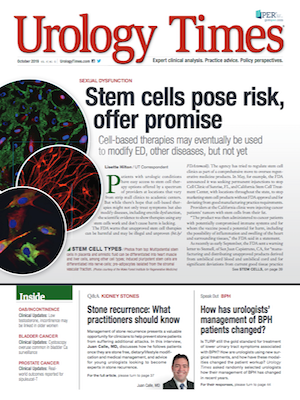Publication
Article
Urology Times Journal
Model highlights cost savings of single-stage SNM
Author(s):
Sacral neuromodulation placement in a single-stage procedure is likely to be less costly than a two-stage approach for most practitioners, according to the findings of a cost minimization analysis.
wladimir1804 - stock.adobe.com

Sacral neuromodulation (SNM) placement in a single-stage procedure is likely to be less costly than a two-stage approach for most practitioners, according to the findings of a cost minimization analysis.
The research, which was presented at the AUA annual meeting in Chicago, showed that the potential for savings and the amount were tied to SNM success rates and reimbursement rates. In the ambulatory surgery center (ASC) setting, performing a single-stage procedure became potentially economically advantageous when the success rate of a two-stage procedure was ≥65.4%. For procedures done in an outpatient hospital department (OHD), the minimum SNM success rate needed to achieve savings with a single-stage operation was 61.4%.
Also see: Low testosterone, incontinence may be linked in older women
Both of those thresholds are below the reported national average success rate of 69%, said Andrew J. Sun, MD, a urology resident at Stanford University, Stanford, CA.
Cost savings up to $5,000 per case
At the two thresholds, the modeling determined that there would be an approximate $600 savings for procedures done in an ASC and an approximate savings of $1,350 for OHD procedures. At centers of excellence where the success rates are reported to be around 90%, the cost savings were estimated to reach approximately $5,000 per case, reported Dr. Sun, working with Christopher Elliott, MD, PhD, and colleagues.
“Payers control what we as practitioners can do. Currently, Medicare is the payer for the majority of SNM procedures and requires that placement be done in a two-stage approach,” he said.
“Our estimates are from theoretical models and do not incorporate the benefits of a single-stage procedure from the patient preference perspective, but we tried to make them as realistic and generalizable as we could. We hope that our findings will motivate payers to revisit their policies. It is notable that Kaiser Permanente, which is a closed system, has gone to a single-stage procedure in Southern California, likely reflecting the economic advantages of the single-stage approach.”
The base model used published data on SNM variables when available and 2017 national average reimbursements from Medicare for cost data.
“A previous study modeling the potential cost savings of a single-stage procedure used institution specific success rate and cost data. Therefore, its findings may not be generalizable,” Dr. Sun said.
Continue to the next page for more.
The inputs used for the base case analyses included a 69% success rate for the testing phase of the two-stage procedure and for single-stage cases, a 100% success rate for the second stage in a two-stage approach, and infection rates of 5% for a two-stage approach and 1.7% for a single-stage approach. The latter rate was extrapolated from published data on the infection rate associated with implantable cardiac defibrillators.
The model assumed that in cases where infection developed, 100% of devices would be removed and there would be one attempt at replacement. In cases of failure after single-stage implantation, it assumed that 50% of patients would elect to have the device surgically removed.
Read: Positive dipstick does not preclude BTX injections
Sensitivity analyses were also performed that varied the infection rate and the rate of device removal upon failure after a single-stage procedure in the absence of infection. Results showed that the single-stage procedure remained less costly for most infection and removal rates, even assuming that 100% of single-stage patients who failed would want the device removed.
Dr. Sun noted that the main barrier for implementation is the lost revenue to facilities and, to a lesser extent, lost revenue for surgeons. Surgeons, however, could potentially make up for the lost revenue by filling the OR time and clinical visit time with another patient.
“The facility loss is harder to recoup, but potentially the OR time could be filled with a different case,” Dr. Sun said.
Comments? Contact editor Richard R. Kerr at urology_times@mmhgroup.com

Newsletter
Stay current with the latest urology news and practice-changing insights — sign up now for the essential updates every urologist needs.





























